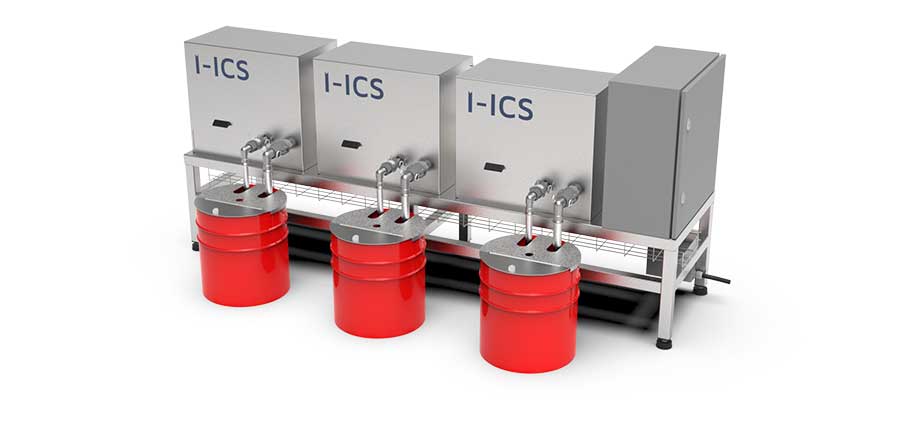From the beginning, the flexible material printer, using flexographic or rotogravure techniques, has had the need to control the color obtained in this process, which is called conversion. Today we will talk about the viscosity meter for inks.
The ink is, in essence, a mixture of pigment that provides the color and resin that fixes the pigment onto the substrate and the solvent that gives the ink an adequate viscosity or flowability to be able to move from the chromed cylinder to the gravure material, as well as from the anilox cylinder to the cliché, and from this to the support to be printed on via flexography.
Of these three main components, the ratio between the resin and the pigment is fixed, since they do not evaporate and are consumed at the same time. The same does not happen with the solvent that does evaporate and, therefore, changes the proportion between this and the solids responsible for the color, thus modifying the tone or intensity obtained.
From all of the above we understand that maintaining the solid-solvent ratio allows us to obtain a constant color, and this ratio is directly proportional to the viscosity of the ink. Therefore, by keeping the viscosity constant we will have a constant solids concentration and, therefore, the same color on the printed support.
We have then an easy way to control and maintain color by using viscosity meters.
The evolution of the viscosity meter for inks
Viscometers, over time, have been adapting to the needs of the sector. At first, they were manual systems like the Ford or Zahn cups, based on the time needed for an ink to discharge from a container (the cup). Said container has different names and numbers, depending on the shape and size of the discharge hole. Currently, they are more sophisticated electronic systems, used in different technologies to measure viscosity:
• Systems based on the working frequency of a pneumatic pump when sending ink to the printer. It is the simplest but the most imprecise system.
• Line pressure reading systems: a sensor in the conduit that carries the ink and measures the pressure exerted by it. At more viscosity there is more pressure.
• Vibration viscosity meters (also called ultrasound), a palette vibrates inside the ink reaching a different frequency for each viscosity.
• Viscosity meter for inks of body drop that measure the time it takes for a body immersed in the ink and confined in a tube, usually glass, where longer times correspond to higher viscosities.
Once an automatic viscosity meter is installed, maintaining the color is very simple, as long as the ink is kept at a constant temperature. A fact that normally does not happen, since the printing process itself raises the temperature of the inks.
Viscosity principle in inks
The problem is that the viscosity of the inks can vary not only by the difference in the amount of solvent in the mixture, but also by temperature changes. Let’s see what happens with an example:
A 25 ° centigrade ink, diluted by 20% (for example), has a viscosity of 28” in a Ford 4 cup, that same ink with the same degree of dilution at 30 degrees will have a viscosity of 24”, lower.
This happens in countless materials, such as oils, plastics, wax, fats of all kinds: at higher temperatures they flow better (they have a lower viscosity).
What is the result of working with normal viscometers at constant viscosity when the ink temperature changes?
Let’s see it again with another example:
A job with an ink at 25 ° Celsius and 25 ”in Ford 4 cup (suppose with a dilution of 20%), by adding colder ink at the same dilution, for example at 20°, we will obtain a viscosity of 30”, more high not because of the change in dilution that is maintained at 20%, but because the ink at a lower temperature flows worse (its viscosity increases). At that time, the viscometer detects the increase in viscosity and adds solvent to reach the 25” setpoint, which increases the proportion of solvent from 20 to 25%. We have a less intense tone!
The solution to the error, introduced by viscosity meters, is to measure and compensate for the difference in viscosity caused by changes in temperature, so that they only correct for variations in solvent ratio, but not for those caused by temperature variations.
We have in this case viscosity meters with temperature compensation, also called solids concentration controls (pigment and resin), which guarantee a uniform color throughout the run.
An additional advantage, which the most sophisticated concentration controls can offer, is to assign a numerical value to the setpoint concentration (not the viscosity). By using this value in successive repetitions of the same work, we will obtain the same color in the first printed meter, reducing the color adjustment times to zero as long as our anilox cylinder has the same volume (is clean) in flexography or, in the case of gravure, our engraving cylinder is in good condition (not too worn).
